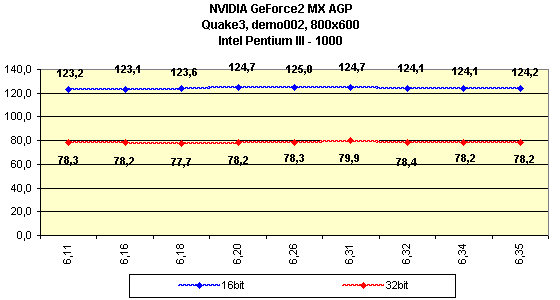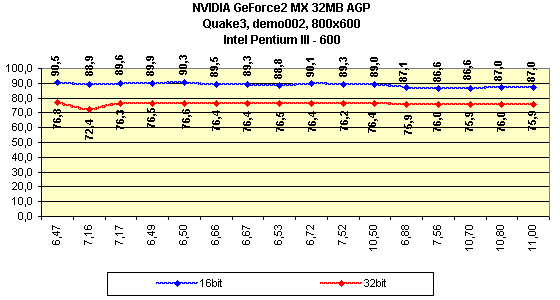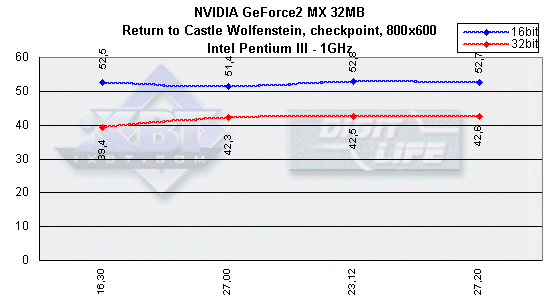 |
||
|
||
| ||
This chip is presented by NVIDIA GeForce2 MX 32 MBytes AGP reference card. Features:
Wasn't overclocked. After the release of GeForce256 cards, NVIDIA representatives have began to understand that following releases wouldn't replace previous cards due to the short period between the new releases. Therefore it has been decided to build a so-called 'ladder' of the market niches, so that every accelerator would have belonged to one of them according its price and perfomance. The release of GeForce2 GTS has been marked by a much higher price for them than for any other of the previous cards. It has been meant that a cheap solution named GeForce2 MX would follow the release of more expensive variants to occupy a low cost niche and to replace more expensive and less faster GeForce256 cards. So, the Summer'2000 has brought us GeForce2 MX that is very popular today. And though this exact GPU is the lowest, its speed and perfomance features very well correspond with the low price for such cards. Now the production of these chips is cancelled due to the development of GeForce2 MX line and due to the release of GeForce2 MX400. Thus we observe as the next replaces the previous, taking into account that prices are almost equal. And soon GeForce2 MX might be replaced by more powerful GeForce2 Ti, which prices are reducing (and GeForce2 MX prices can't be reduced anymore). For the 20th of January 2002 the latest drivers from NVIDIA are 16.30, 23.12, 27.00 and 27.20.




I want readers to note 7.16 and 7.17 version drivers, they are just "raw" and can't function properly even on beta level. Direct3D games show big speed falloff along with lots of visual artefacts. 6.66, 6.67 and 12.41WHQL versions are shipped with NVCPL.DLL that "doesn't know magic Coolbits variable" that makes it impossible to tune frequencies and VSync for D3D in the display settings. As we began to use S3TC in this digest, 12.60 drivers are presented twice: with and without S3TC. The latest drivers are rather ambiguous, as sometimes 14.10 is better than 14.70, and vice versa. Detonator XP (version 21.81) demonstrated some perfomance increase, but there is some criticism about stability. These bugs are fixed in 21.8* versions. And 22.* versions cause some quality (22.50, 22.80) and stability (22.40) problems. As you could have already read in the December 3Digest, 23.11 version is beneath all criticism, being at that a release. The majority of bugs showed up on VIA platforms and chipsets even with installed 4in1 drivers. Though I recommend to refrain from using these drivers and use the most stable version 21.85 and also rather good version 27.20. I shall mark that overlay settings tab is disabled in a number of 14.*, 21.88, and 22.* versions. It may be enabled with RivaTuner utility. You can compare screenshots with reference ones (NVIDIA GeForce3).
Game list:
There are some games that require something more powerful than this card. Look at Rally Trophy screenshot - we've had to lower quality, but the game was very slow even at medium settings and disabled reflections. I shall mark that these cards sometimes have Z-buffer working incorrectly in 32-bit mode when Z-buffer itself is 16-bit, what causes artefacts. Such problems were noticed on some games with Unreal Tournament engine. Thus I recommend you to use utilities like Riva Tuner for fine tuning, and pay attention to Direct3D settings of such games. 2D quality is very good for all but maybe 21" monitors. Soaping effects can be seen only on some low-quality monitors in 1600x1200x75 Hz and in 1280x1024x100 Hz. But there are some low-quality cards present that give soaping effect on good monitors. And I shall mark that 6.* version drivers are not compatible with the software for sound cards based on Yamaha processor, as well as with SoftXG100 software synthesizer. Start or Close Window buttons can be spoiled by some "garbage" in 2D mode.
|
Platform · Video · Multimedia · Mobile · Other || About us & Privacy policy · Twitter · Facebook Copyright © Byrds Research & Publishing, Ltd., 1997–2011. All rights reserved. |